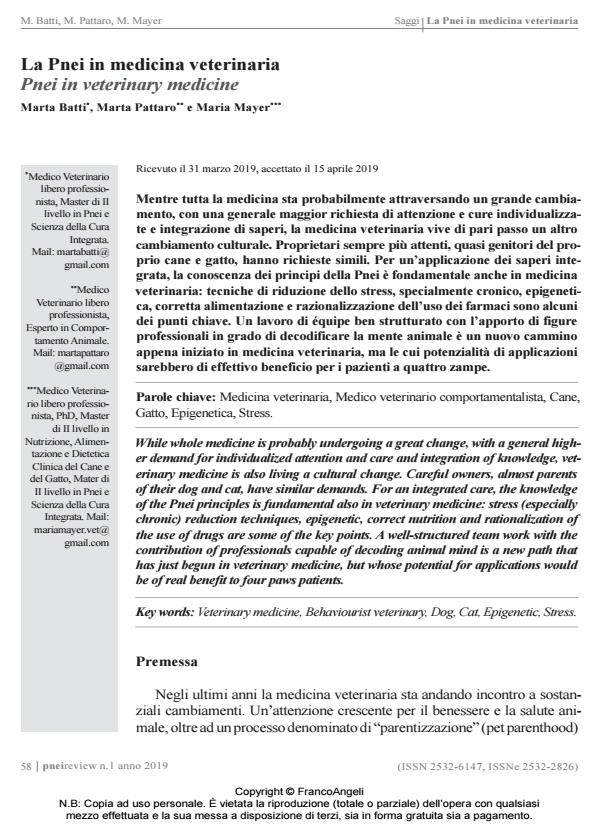Pnei in veterinary medicine
Journal title PNEI REVIEW
Author/s Marta Batti, Marta Pattaro, Maria Mayer
Publishing Year 2019 Issue 2019/1 Language Italian
Pages 13 P. 58-70 File size 1085 KB
DOI 10.3280/PNEI2019-001007
DOI is like a bar code for intellectual property: to have more infomation
click here
Below, you can see the article first page
If you want to buy this article in PDF format, you can do it, following the instructions to buy download credits

FrancoAngeli is member of Publishers International Linking Association, Inc (PILA), a not-for-profit association which run the CrossRef service enabling links to and from online scholarly content.
While whole medicine is probably undergoing a great change, with a general higher demand for individualized attention and care and integration of knowledge, veterinary medicine is also living a cultural change. Careful owners, almost parents of their dog and cat, have similar demands. For an integrated care, the knowledge of the Pnei principles is fundamental also in veterinary medicine: stress (especially chronic) reduction techniques, epigenetic, correct nutrition and rationalization of the use of drugs are some of the key points. A well-structured team work with the contribution of professionals capable of decoding animal mind is a new path that has just begun in veterinary medicine, but whose potential for applications would be of real benefit to four paws patients.
Keywords: Veterinary medicine, Behaviourist veterinary, Dog, Cat, Epigenetic, Stress.
- Ainsworth M.D. and Wittig B.A. (1969). Attachment and exploratory behavior of one-year-olds in a strange situation. In: Foss B.M., ed., Determinants of infant behavior.Vol. 4. London: Methuen.
- Blaze J., Asok A. and Roth T.L. (2015). Long-term effects of early-life caregiving experiences on brain-derived neurotrophic factor histone acetylation in the adult rat mPFC. Stress, 18(6), 607-615. DOI: 10.3109/10253890.2015.107179
- Bottaccioli F. e Bottaccioli A.G. (2017). Psiconeuroendocrinoimmunologia e scienza della cura integrata. Il manuale. Milano: Edra.
- Bowen J. and Health S. (2005). Behaviour problems in Small Animals: Practical Advice for Veterinary Team. Philadelphia: Elsevier Saunders.
- Broom D.M. (1988). The scientifi c assessment of animal welfare. Appl. Anim. Behav. Sci., 20(1-2): 5-19. DOI: 10.1016/0168-1591(88)90122-
- Casey R. (2004). Paura e stress. In: Horwitz D.F., Mills D.S. e Heath S., eds., Terapia comportamentale del cane e del gatto. Torino: UTET Spa Scienze Mediche.
- Colangeli R. e Giussani S. (2004). Medicina comportamentale del cane e del gatto. Milano: Poletto.
- Duncan I.J.H. and Petherick J.C. (1991). The implications of Cognitive Processes for Animal Welfare, J. Anim. Sci., 69(12): 5017-5022. DOI: 10.2527/1991.69125017
- Kerswell K.J., Bennett P., Butler K.L. and Hemsworth P.H. (2009). Self-reported comprehension ratings of dog behavior by puppy owners. Anthrozoös, 22(2): 183-193. DOI: 10.2752/175303709X43420
- Mariti C., Gazzano A., Lansdown Moore J., Baragli P., Chelli L. and Sighieri C. (2012). Perception of dogs’ stress by their owners. J. Vet. Behav., 7(4): 213-219.
- Mills D.S., Ramos D., Estelles M.G. and Hargrave C. (2006). A triple blind placebo-controlled investigation into the assessment of the effect of Dog Appeasing Pheromone (DAP) on anxiety related behavior of problem dogs in the veterinary clinic. Appl. Anim. Behav. Sci., 98(1-2): 114-126.
- Nibblett B.M., Ketzis J.K. and Grigg E.K. (2015). Comparison of stress exhibited by cats examined in a clinic versus a home setting. Appl. Anim. Behav. Sci., 173: 68-75.
- Papitto G. (2017). Floriterapia australiana: un valido aiuto nella pratica ambulatoriale giornaliera. Relatore: Amorena M., Correlatore: Mayer M., Tesi del Corso di Laurea in Tutela e Benessere Animale, Facoltà di Medicina Veterinaria, Università di Teramo.
- Parker V.J. and Douglas A.J. (2010). Stress in early pregnancy: maternal neuro-endocrine-immune responses and effects. J. Reprod. Immunol., 85(1): 86-92.
- Raspanti E. (2012). Analisi del comportamento del cane nella sala di attesa dell’ambulatorio veterinario. Relatori: Gazzano A., Mengoli M. e Mariti C. Tesi sperimentale presso Facoltà di Medicina Veterinaria, Università di Pisa.
- Rushen J. (1993). The “coping” hypothesis of stereotypic behaviour. Anim. Behav., 45(3): 613-615.
- Topál J., Miklósi Á., Csányi V. and Dóka, A. (1998). Attachment behavior in dogs (Canis familiaris): a new application of Ainsworth’s (1969) Strange Situation Test. J. Comp. Psychol., 112(3): 219-229. DOI: 10.1037/0735-7036.112.3.21
- Weaver I.C., Cervoni N., Champagne F.A., D’Alessio A.C., Sharma S., Seckl J.R., Dymov S., Szyf M. and Meaney M.J. (2004). Epigenetic programming by maternal behavior. Nat. Neurosci., 7(8): 847:854.
Marta Batti, Marta Pattaro, Maria Mayer, La Pnei in medicina veterinaria in "PNEI REVIEW" 1/2019, pp 58-70, DOI: 10.3280/PNEI2019-001007